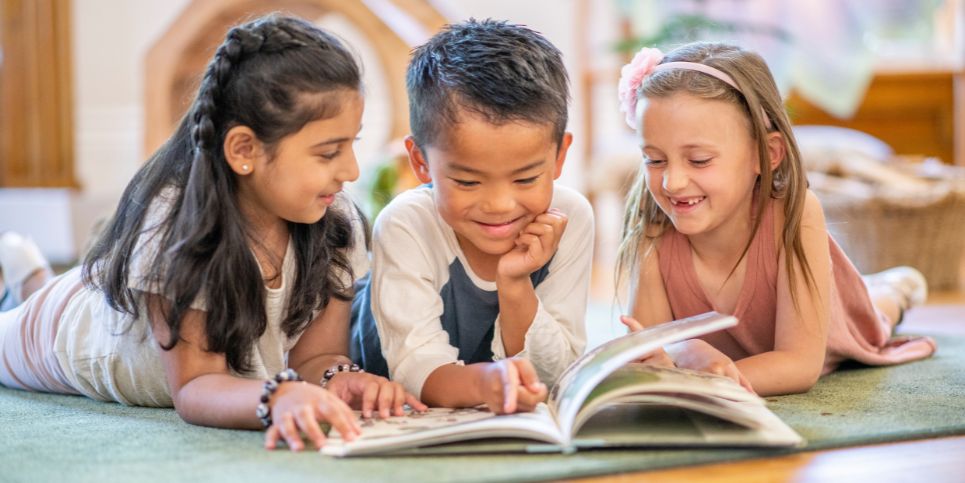On The Children’s Book Review, author Lori Calabrese breaks down how books relate to child development and the importance of picture books:
We all want what’s best for our kids and like the Army commercial, we want them to be all they can be. But parents can often succumb to the pressures of society and other parents to compete. That’s why some parents buy everything imaginable to get their baby to read, they enroll their children in the most expensive preschools, and even skip picture books and encourage their children to move on to more text-heavy chapter books as a means to advance their skills for rigorous standardized testing.
It’s not a new issue, but it was recently brought back to the forefront by the NY Times article “Picture Books No Longer a Staple for Children.” The article sadly reports that “The picture book, a mainstay of children’s literature with its lavish illustrations, cheerful colors and large print wrapped in a glossy jacket, has been fading.” Although the article reports that staples from Maurice Sendak and Dr. Seuss still sell, publishers have scaled back the number of titles. Citing the economic downturn as a major factor, the article points out that many in the industry see an additional reason—parents.
But while these parents are pushing their kids to be on top of the game, they don’t realize that the intensive coaching can be counterproductive and they’re missing out on an important genre, critical in the role of a child’s development—picture books.
So why are picture books important?
10. Chapter books are not necessarily more complex than picture books and in fact, their vocabulary and sentence structure can be considered simplistic when compared with older-level picture books. Many picture books are written at a higher reading level, use amazingly complex vocabulary, and offer interesting plots.
9. The illustrations of a picture book help children understand what they are reading and allow young readers to analyze the story. When children are having difficulty, the illustrations can help them figure out the meaning of what they are reading. The illustrations are also a powerful way to help English learners comprehend the story.
8. Children love art. Why do you think they spend so much time coloring, drawing, and doing crafts? Whatever the reason children are drawn towards a book, it’s a means to get them to read.
7. Language: Picture books allow children to practice the sounds of language and as parents, it’s our responsibility to introduce new and interesting words at every opportunity. The rhythm and rhyme in many picture books make for a great read-aloud and children learn words more easily when they hear them spoken often.
6. Repetition: The repetition in many picture books allows a child to participate in the story. Young readers get excited when they can anticipate a forthcoming line and children learn skills like phonemic awareness, phonics, comprehension, and fluency.
5. Picture books are multi-sensory, which aids a child’s growing mind and stimulates their imagination. Not only do the children hear the story, they see the illustrations and smell and touch the pages.
4. Picture books can be a useful tool for teaching the concept of cause and effect. Before reading a picture book to your children, tell them to listen for keywords such as because, so, if, then, as a result of, etc. These types of words can usually be found in a story that has a cause-and-effect relationship.
3. Picture books help develop story sense. Children learn the beginning, middle, and end of a story and can often relate to the age-appropriate issues and conflicts presented in a picture book.
2. Picture books allow an entirely different, more interactive communication between parent and child. Picture books allow parents to spend time talking with their children about the story, pictures, and words. This interaction builds reading comprehension. Picture books allow you to talk about what you see on each page, so be sure to talk about what happened in the story, ask about the characters, how they are feeling, and the events that took place.
1. Picture books are fun and the key is to always make the reading experience fun and a time to look forward to. Reading should never be perceived as a chore. If you make reading a chore early on in a child’s development, they might grow to resent reading. Children who don’t naturally progress from picture books to chapter books may translate reading into working – more specifically, working that isn’t much fun.
It’s unfortunate that parents are pushing their kid’s past picture books, just as some turn up their noses at graphic novels and magazines. It’s important to encourage your kids to get their hands on everything they can, including picture books, comics, and even kid-friendly websites. It doesn’t matter what they read as long as they read and children who learn to love books will be children who grow up to be good readers.
Need help finding good picture books?
Check out the picture book reviews and book lists featured here on The Children’s Book Review
Teachers Pick the Top 25 Picture Books at Scholastic
About the author: Lori Calabrese is an award-winning children’s author. Her first picture book, The Bug That Plagued the Entire Third Grade, was awarded DFP’s Best Children’s Book Award. She writes for various children’s magazines, is the National Children’s Books Examiner at Examiner.com and enjoys sharing her passion for children’s books at festivals, schools and events. Visit her website to learn more, loricalabrese.com.
This article, How Picture Books Play a Role in a Child’s Development, was written by author Lori Calabrese. For similar articles, follow along with our content tagged with Literacy Resources and Picture Books.

